350 Search Results for aided language input
January 13, 2014
by Robin Parker -
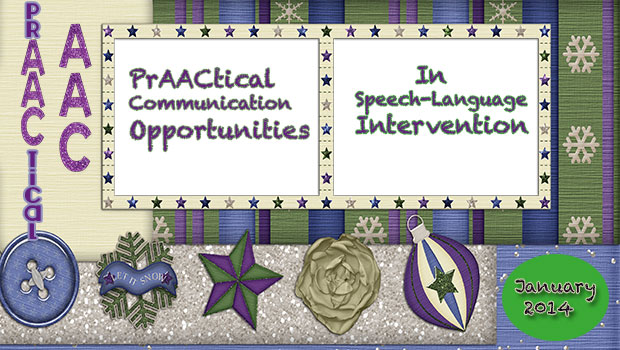
Planning for communication opportunities in every aspect of speech-language therapy helps ensure productive use of time and effort for both clinician and learner. It is not enough to talk to a student, it is not enough to provide fun activities without lots of opportunity for active participation and more specifically communication initiation. Another word for communication initiation/opportunities is communication temptations. Communication temptations are structured situations designed to entice a variety of specific communication functions or semantic relations (Wetherby, 1988). There needs to be lots of times where there is targeted modeling and then a specific, obvious reason for the learner to be the initiator of communication. A temptation to communicate. Take a look at this sample therapy session for frequent and multiple communication opportunities. Please let us know a favorite or creative communication opportunity that you use. PrAACtical Considerations Meaningful AAC Goals– All quality speech-language intervention sessions start with meaningful... [Read More...]
January 2, 2014
by Carole Zangari -
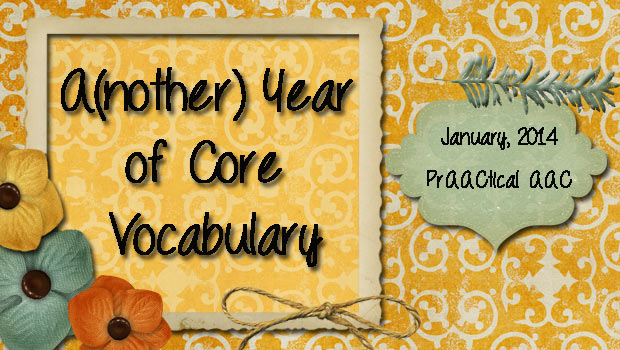
It hardly seems possible that a year has gone by since we posted a Year of Core Words 2013. We’ve been so gratified by the feedback from professionals and parents who’ve put it to good use and followed month-by-month to focus on a dozen core words and get suggestions for additional practice. We were thrilled when others added symbols, created teaching materials, and adapted it for their own use. Today we’re back with the 2nd Year of Core Words, this time with 16 words/month. If you follow along, you’ll have covered 192 new core words by the end. Once again, we created 12 grids of core vocabulary words – one for each month of the year. Each grid has 16 cells labeled with core words. Plug in the AAC symbols that your client uses (e.g., PCS, SmartySymbols, Unity, Pixons, etc.), print, laminate, and keep them handy. Feel free to adapt... [Read More...]
December 31, 2013
by Robin Parker -
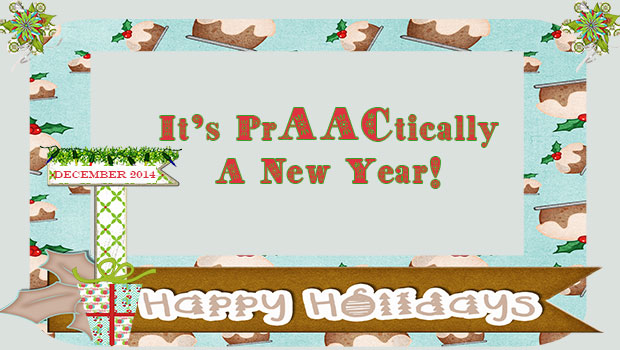
It is just about 2014. Hard to believe another year is finished and we are moving on once again. Our wishes for 2014 are for ALL Learners to have access to: Aided Language Input Communication Displays that meet their needs Role Models Presumed Competence Core Word Instruction Fringe Word Instruction Friends Many Meaningful Language Experiences Frequent Communication Opportunities Fun Learning Our Wishes for ALL SLP’s and Educators to have access to: An Exciting and Stimulating Personal Learning Network (PLN) Appropriate Goals and Strategies Meaningful Language Experiences Role Models Laminator and Laminator Materials Literacy Materials Core Word Highlighter Tools, Page Fluffers & Spacers, Apps for Learning Language An AAC Philosophy Fun Teaching
December 27, 2013
by Carole Zangari -
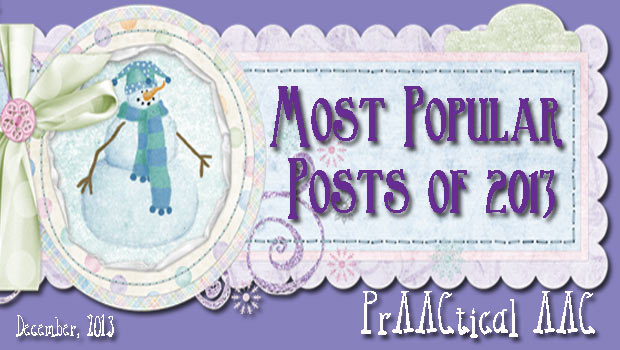
It’s been a wonderfully prAACtical year. Here’s a look back at our top 10 most popular posts. Anyone see any patterns? 🙂 How I Do It: Writing IEP Goals for Students Who Use AAC by Lauren Enders Teaching Core Vocabulary 5 Great Resources for Pre-Made Communication Boards Core Samples A Year Of Core Vocabulary Words AAC ‘Must Haves’ the the Classroom and Therapy Room Pivotal Skills for AAC Intervention: Aided Language Input How I Do It: AAC in the IEP by Lauren Enders Getting Started with Core Vocabulary More on Teaching Core Vocabulary
December 24, 2013
by Robin Parker -

Use social narratives to explain happy upcoming events, stressful upcoming events, and out of the routine type events. Not only do social narratives help with understanding, but they can also help with ways to talk about activities and events. Use Aided Language Input (ALI) to model. It will show that even when there is a lot going on, AAC is still important and a high priority. Give out some AAC related presents to educators, professionals, families, and AAC users. Create the visual supports for holiday songs and poems. Or use a single step or sequential message device to record the songs, so everyone can sing together. You can even program the songs into high tech devices and have quite the good singing voice. Provide frequent communication opportunities for the AAC user to make choices, give opinions, rate activities and events, vent, ask questions, tell, and share information. Make talking photo... [Read More...]
December 14, 2013
by Robin Parker -
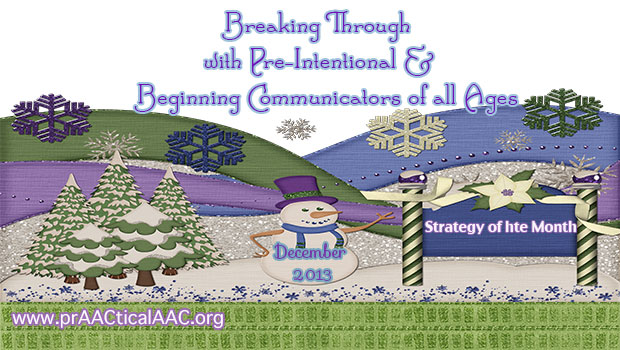
We are thinking a lot about emerging-intentional and beginning communicators. Even within these categories it seems there are sub-categories. We have a subset of learners who seem difficult to engage. They do not often respond to communication initiations by others. They can be content looking at small items or through self-stimulatory behaviors. These learners can get “communication” overlooked in class, in intervention, and at home because they can be quiet and subdued a lot of the time. They can be prompted through activities and events without difficulty but they often do not get to be communication initiators. And without a lot of practice initiating, it is hard to improve. You may hear or think these things about the learner: She does not like anything He is in his “own world” He does not care what he gets It seems like she can not hear She does not look at what... [Read More...]
December 12, 2013
by Robin Parker -
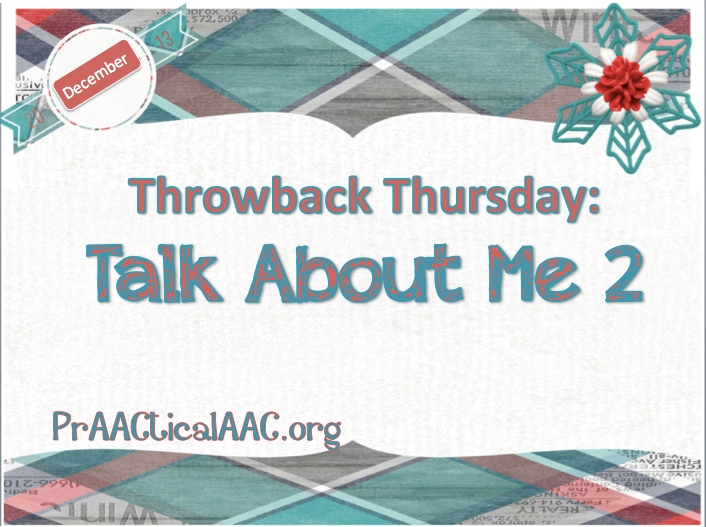
originally published December 13, 2012 We write about a lot of AAC strategies and we often give examples of different types of learners. Sometimes the learners we work with have more challenges than we explain. Lest you think, we do not see the really ‘challenging’ learners, we do, we really do. For those individuals with more challenges than most, sometime we are asked, well what do a few visual supports or AAC strategies do? What difference do they make? The truthful answer is A LOT. Here are a just a few recent examples from some really amazing families. When a mom is on the phone, a young adult brings in a timer and sets it so mom will get off the phone and go sit with her. When a communication book is forgotten on an emergency trip to the dentist, drawing on a napkin is enough to keep everyone calm... [Read More...]
November 30, 2013
by Robin Parker -
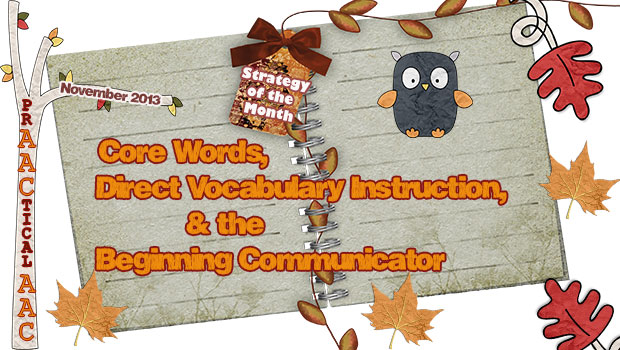
Direct vocabulary instruction is important for all level learners. The beginning communicator needs to learn core word vocabulary from USING the words and one of the best ways to learn how to USE core words, is to receive specific direct instruction with many opportunities for active participation. 6 Essential Philosophies & Strategies Vocabulary instruction involves a systematic TEACHING process. Add vocabulary or Words as an activity on the daily schedule and then have a mini-schedule for the specific vocabulary instruction activities for that day. Initially, apply an errorless learning paradigm. Then, gradually, add comprehension checks, but do not wait for ‘proof’ of comprehension before adding new words because we often notice that the beginning communicator will demonstrate comprehension during ‘unexpected opportunities- or when you are least expecting it. Once learners become familiar with some of the specific vocabulary activities, then have some choice making opportunities as to which ‘word activities’... [Read More...]
November 29, 2013
by Robin Parker -
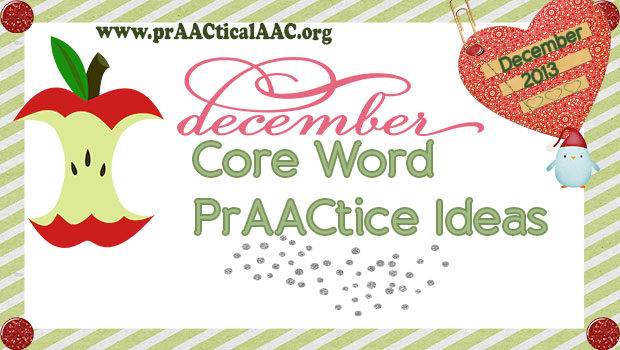
December core word prAACtice ideas are here. The best way to TEACH core words is to first provide Aided Language Input- ALI in Meaningful Language Experiences. Then give the learner a chance to be an active participant by having many (many, many) opportunities to USE the core words to request, question, complain, tell, negotiate, explain, refuse, tattle, greet, ask, vent, and discuss. There is a lot of holiday spirit this month. Here are some ideas of activities that can go with the core word words, phrases and sentences: Play Holiday Music– All holidays can be represented. Model “hear it louder”, “surprise us” for the next song, or even wear “silly hats” while singing. Cook & Eat Fun Holiday Food– As you are creating/cooking holiday treats, everyone can take a turn saying “mix it this way” or “add it this way“. Have each learner say “these next” or “please one more” or even “I want... [Read More...]
November 25, 2013
by Carole Zangari -

As any experienced AAC professional will tell you, people who are learning to use AAC systems don’t produce as much verbal output as their speaking peers. And, every once in awhile, we run into an AAC learner who communicates VERY infrequently even though they are capable of doing more. They’re often described as shy (perhaps) or stubborn (cringe! shudder! clench teeth!), but, in our view, their reluctance to communicate is probably related to a few other things. We generally don’t like to do things that are difficult for us, particularly if the pay-off is not in proportion to the effort, or if there are insufficient supports. If the learner has had a history of being unsuccessful or associates communication with a high level of effort, it makes sense that they are not rushing to interact with us. It doesn’t always pay to rush things. Sometimes we get better outcomes by building... [Read More...]









